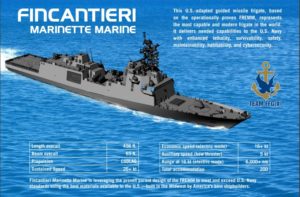A Navy official on Wednesday argued that changes to the parent design of the Constellation-class frigate largely came from the initial bid to meet the Navy’s requirements.
“From a FREMM perspective, discounting C4I and discounting the combat systems weapons that are all government furnished equipment, the FREMM came along with a hull, accommodations, came along with propulsion, plant layout, mechanical systems, electrical systems and a physical integrated plant as far as how it’s just laid out. All that goodness is in the FFG(X) but what we did as the Navy, as we were going through the concept design phase where we were collaboratively working with all those parent designs and all those five shipbuilders, we were looking at the U.S. Navy standards that we have in our shipbuilding,” Capt. Kevin Smith, program manager of frigate class, PMS-515, said during the Surface Navy Association’s annual symposium.
The Navy awarded Fincantieri’s Marinette Marine a $795 million contract in 2020 for the detail design and construction of the first frigate, with options for the following nine ships. The ship is based on the company’s Italian and French FREMM multipurpose frigate (Defense Daily, April 30, 2020).
The Navy’s competition required competitors to use parent designs in a push to speed up production and delivery and reduce overall risk.

Smith argued the Navy has reliability requirements to ensure a certain degree of survivability, maintainability, habitability and lethality along with Government Furnished Equipment (GFE) that drove the changes from the original FREMM.
Last August, Smith said the Constellation-class design is very similar to the parent design and “you can say we bought a bigger house and from a modeling and simulation perspective, it’s exactly the same. So it’s more, just guess you would say, scale” (Defense Daily, Sept. 9, 2021).
In September, the Congressional Research Service (CRS) outlined changes from the original FREMM design.
Smith said the competitors integrated various Navy requirement factors into all the parent designs.
“So in this particular instance with Fincantieri, they went off and looked at what are those standard requirements against our FREMM parent. And they had to lengthen the hull a little bit, then had to look at the stateroom layout as far as survivability, they had to look at how are we going to look at the architecture for the propulsion. The layout is very, very similar to FREMM, but we also have U.S. systems and we have different redundancy and reliability requirements.”
“So when someone says you’ve changed the design, no that was in their bid, this was how they bid the bid,” Smith continued.
He said since they have moved to the current detail design and construction phase the only thing that the Navy changed was adding buy America requirements as directed by congressional statute.
Smith said he wanted to “make sure it was clear that we have not changed the design, that’s how they bid it based on what we want as a U.S. Navy.”
Smith also underscored he believes the parent design process was clear to Navy and congressional leadership as akin to DNA with “all the goodness of that parent, the hull, the way it’s laid out, all of that is in the design. But, you have to take up Navy standards and apply those and also the requirements and so that was the bid they proposed.”
He said Fincantieri is committed to being a first-time prime contractor with the frigate and he has talked to company leadership recently.
“They want to build a quality ship, they want the market and they want to have a fantastic frigate so they have been working well with the government here to make sure that the requirements are met.”
Smith said while Fincantieri does not have experience integrating an Aegis system, they have grown quickly to integrate it properly.
“They’ve hired a lot of talent that used to work Aegis and they understand the GFE requirements and what’s really important…So they’ve quickly got on board with that this last year.”
The frigate will have an Aegis Baseline 10 combat system like that featured on the Arleigh Burke-class DDG-51 Flight III destroyers.
Smith admitted while lead construction for the first frigate, the future USS Constellation (FFG-62), was planned for this April, he said it might take longer to start but would still start this year.
“We’re targeting that date, right now as I said we’re coming through design so there could be some risk to that but we’re looking hard at that…we want to make sure that we don’t start building a ship where the design is not mature. So right now we’re looking at this year.”